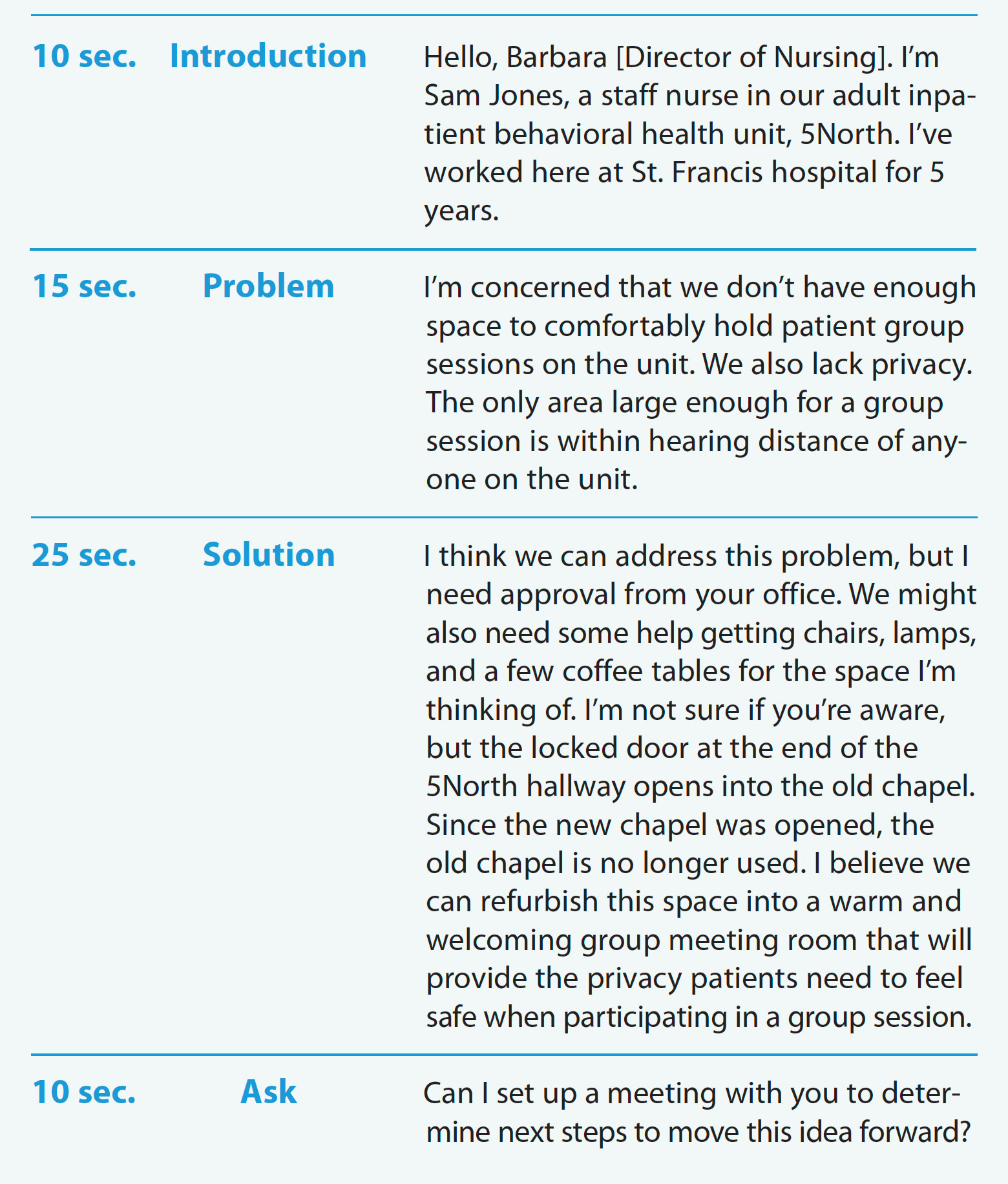Be prepared when opportunity presents itself.
Takeaways:
- Nurses have a duty to advocate for change and solutions that will benefit individual patients, groups, communities, and populations.
- An elevator pitch, which can be presented in the time it takes for a typical elevator ride (about 60 seconds), is an opportunity to succinctly describe a problem, suggest a solution, and request follow-up.
No matter your practice setting, you can probably identify areas you’d like to improve or change. To influence decision-making in your practice environment or organization you need to advocate. Advocacy—for individuals, groups, communities, or populations—is inherent in nursing and supported by the American Nurses Association Code of Ethics for Nurses with Interpretive Statements. Most advocacy opportunities will come when you least expect them, such as during an impromptu meeting with a decision maker, so you should be prepared with an elevator pitch.
What’s an elevator pitch?
Traditionally, elevator pitches (short speeches that can be completed in the time it takes to ride an elevator—about 60 seconds) are designed to sell yourself to a potential boss. However, you also can use them to advocate for your cause or idea. To be ready when the moment presents itself, craft a brief, cogent case for your idea. In nursing terms, you can think of the elevator pitch as a “teachable moment,” except, in this instance, you’re speaking with a decision maker not a patient or family member. Although many elevator pitches are given during an impromptu meeting, you also can use them as an initial pitch in a more formal situation such as an agenda item at a meeting. Some nurses feel intimidated or ill-equipped to advocate for their ideas, but this strategy will prepare you to make “the ask.”
Anatomy of a 60-second elevator pitch
The key to a successful elevator pitch is preparation. There’s a difference between being informed and passionate about a topic and stating your case in a succinct and compelling way. The elevator pitch is broken down into four sections—introduction, problem, solution, ask.
- Introduction (10 seconds)
Start with a brief introduction (who you are and where you’re from). You may want to talk more about yourself, but it’s better to spend time in the other sections, using your time to describe the problem and potential solutions.
- Problem (15 seconds)
Next, describe a problem you believe this person can help you solve. Engage the listener by including some data or a story to support why you believe the problem needs to be addressed. To avoid rushing, your story or example should have no more than three main points: the problem, who the problem impacts, and how it impacts them.
- Solution (25 seconds)
Spend most of your time on the solution. Share your proposed solution and tell the decision maker how you believe it will solve the problem. Address only the problem you’ve identified; you may be tempted to discuss other problems, but this will only muddy the waters. You have 25 seconds for this section of the pitch, but excitement and passion about the topic will make them pass quickly.
- Ask (10 seconds)
Ask for what you need to move toward the solution. When you ask a question, you create an invitation for interaction. For example, if you want to convert unused space into a family-friendly waiting area, you might ask, “Can I set up a meeting with you to determine next steps to move this idea forward?” Securing a commitment to meet again or follow up in some way to advance your solution. (See Elevator pitch example.)
Elevator pitch example
This example shows how you can use an elevator pitch to advocate for solutions to problems you’ve identified.


Pursue positive change
Using an elevator pitch to advocate for the solution to a problem you’ve identified requires preparation and practice (including writing the speech and practicing it out loud with a friend). Be brief, compelling, and authentic. Don’t try to include too much information and don’t rush. Strike a conversational tone and avoid being adversarial or overly authoritative. Make what you’re advocating for important to the listener.
There’s no limit on the number of elevator pitches you can create. Positive change usually doesn’t happen by accident. You must be ready to pursue it. AN
Catherine F. Yonkaitis is a clinical assistant professor and director of the advanced population health doctor of nursing practice program at the University of Illinois at Chicago – College of Nursing in Chicago, Illinois.
References
American Nurses Association. Code of Ethics for Nurses with Interpretive Statements. Silver Spring, MD: American Nurses Association; 2019. nursingworld.org/practice-policy/nursing-excellence/ethics/code-of-ethics-for-nurses/coe-view-only/
Bergren MD. Persuasive presentations: How to speak so people will listen. NASN Sch Nurse. 2018;33(4):220-1.
Kachel D. Using research in talking points and elevator speeches. Teach Librarian. 2015;43(1):36-40.
Nemec-Loise J. It’s how you say it: Using value-based language for elevator speech awesomeness. Children and Libraries. 2015;13(1):32-3.
Union J. Three questions to ask when preparing an elevator speech. Nonpr Com Rep. 2017;15(3):3.

















